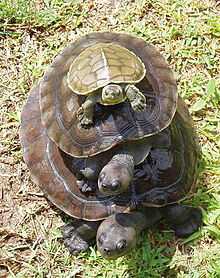Brown roofed turtle
| Brown roofed turtle |
| Conservation status |
| |
| Scientific classification |
| Kingdom: |
Animalia |
| Phylum: |
Chordata |
| Class: |
Reptilia |
| Order: |
Testudines |
| Suborder: |
Cryptodira |
| Family: |
Geoemydidae |
| Genus: |
Pangshura |
| Species: |
P. smithii |
| Binomial name |
Pangshura smithii
|
|
| Synonyms[1][2] |
- Batagur smithii Gray, 1863
- Pangshura smithii (Gray, 1863)
- Pangshura smithii smithii
- Batagur smithii Gray, 1863
- Pangshura smithii Günther, 1864
- Clemmys smithii Strauch, 1865
- Pangshura smith Theobald, 1868 (ex errore)
- Emia smithii Gray, 1870
- Kachuga smithii Boulenger, 1889
- Kachuga smithi Smith, 1931 (ex errore)
- Kachuga amithii Rudloff, 1974 (ex errore)
- Kachuga smithi smithi Moll, 1987
- Kachuga smithii smithii Moll, 1987
- Pangshura smithii smithii Das, 2001
- Pngshura smithii Das, 2001
- Pangshura smithi Gurley, 2003
- Pangshura smithi smithi Joseph-Ouni, 2004
- Pangshura smithii pallidipes
- Kachuga smithii pallidipes Moll, 1987
- Kachuga smithi pallidipes van Dijk, 2000
- Pangshura smithii pallidipes Das, 2001
- Pangshura smithi pallidipes Joseph-Ouni, 2004
|
Brown roofed turtle (Pangshura smithii) , the is a species of the Geoemydidae family of turtles found in South Asia.
Description
Carapace much depressed, feebly keeled. Nuchal shield small, trapezoidal, broadest posteriorly; first vertebral with sinuous lateral borders, usually a little narrower in front than behind; second vertebral shortest, broader than long, usually with straight or slightly convex posterior border; third vertebral considerably longer than broad, subquadrangular, posterior border straight or slightly convex, fourth vertebral longest, tapering anteriorly and forming a narrow suture with the third; fifth vertebral much broader than the others. Plastron feebly angulated laterally, large; front lobe rounded, hind lobe angularly notched and as long as or a little shorter than the width of the bridge; the longest median suture is that between the abdominals, which about equals the length of the front lobe; gulars usually shorter than the suture between the humerals, their suture with the latter shields forming a right angle; inguinal large, axillary smaller. Head moderate; snout short, obtuse, feebly prominent; jaws with denticulated edge, upper not notched mesially; alveolar surface of upper jaw broad, the median ridge nearer the inner than the outer border; bony choanae between the orbits; the width of the lower jaw at the symphysis is less than the diameter of the orbit. Fore limbs with large transverse scales. Pale olive-brown above; dorsal keel usually blackish; plastral shields and lower surface of marginals dark brown, bordered with yellow. Length of shell 8.5 inches.[3]
- Races
- smithii: Indus, Ganges and Brahmaputra river drainages in Bangladesh, India and Pakistan
- pallidipes: northern tributaries of the Ganges in India and Nepal
References
 This article incorporates text from Reptilia and Batrachia, Volume 10, by George Albert Boulenger, a publication from 1890 now in the public domain in the United States.
This article incorporates text from Reptilia and Batrachia, Volume 10, by George Albert Boulenger, a publication from 1890 now in the public domain in the United States.
External links
|
|---|
| | | | Suborder | |
|---|
| | Cryptodira | | |
|---|
| | | Carettinae | |
|---|
| |
- Chelonia
- Eretmochelys
- Natator
|
|---|
|
|---|
| | |
|---|
|
|---|
| | |
|---|
| | |
|---|
| | |
|---|
|
|---|
| | Pleurodira | | | Chelinae | |
|---|
| Chelodininae | |
|---|
| Hydromedusinae | |
|---|
|
|---|
| | |
|---|
| | |
|---|
|
|---|
|
|---|
| |
|
![]() This article incorporates text from Reptilia and Batrachia, Volume 10, by George Albert Boulenger, a publication from 1890 now in the public domain in the United States.
This article incorporates text from Reptilia and Batrachia, Volume 10, by George Albert Boulenger, a publication from 1890 now in the public domain in the United States.
